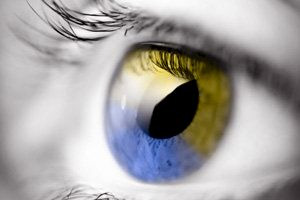People with dichromatic colour vision have only two types of cone cells which are able to perceive colour i.e. they have a total absence of function of one cone cell type , resulting in a specific section of the light spectrum which can’t be perceived at all. For convenience we call these areas of the light spectrum ‘red’, ‘green’ or ‘blue’. The sections of the light spectrum which the ‘red’ and ‘green’ cone cells would normally perceive overlap significantly, so people with red and green types of colour blindness experience many similar colour confusions. This is why red and green colour vision deficiencies are often known as red/green colour blindness and why people with red and green deficiencies often see the world in a similar way.
People with protanopia are unable to perceive any ‘red’ light, those with deuteranopia are unable to perceive ‘green’ light and those with tritanopia are unable to perceive ‘blue’ light.
People with both red and green deficiencies live in a world of murky greens where blues and yellows stand out. Browns, oranges, shades of red and green are easily confused and people with both types will also confuse some blues with some purples and struggle to identify pale shades of most colours.
However, there are some specific differences between the two types of red/green deficiencies.
Protanopia
Protanopes are more likely to confuse:-
1. Black with many shades of red
2. Dark brown with dark green, dark orange, dark red, dark blue/purple and black
3. Some blues with some reds, purples and dark pinks
4. Mid-greens with some oranges
Deuteranopes
Deuteranopes are more likely to confuse:-
1. Mid-reds with mid-greens
2. Blue-greens with grey and mid-pinks
3. Bright greens with yellows
4. Pale pinks with light grey/white
5. Mid-reds with mid-brown
6. Light blues with lilac
Tritanopes
The most common colour confusions for tritanopes are light blues with greys, dark purples with black, mid-greens with blues and oranges with reds.
The images above show how the beautiful colours of the pigments are lost to people with each type of dichromatic vision.
Monochromacy (achromatopsia)

Normal Vision

Monochromacy
People with monochromatic vision can see no colour at all and their world consists of different shades of grey ranging from black to white, rather like seeing the world on an old black and white television set. Achromatopsia is a specific eye condition in which people see in greyscale. We do not specifically support achromatopsia because of its additional symptoms. Achromatopsia is extremely rare, occuring only in approximately 1 person in 33,000 and its symptoms can make life very difficult. Usually someone with achromatopsia will need to wear dark glasses inside in normal light conditions.
We occasionally have had very concerned people contact us because they or their children have been diagnosed by their optician with ‘total colour blindness’. Although we are unable to advise on the diagnosis of specific cases we have undertaken further research to try and understand why so many people are being told they are totally colour blind when in reality they are much more likely to have a severe form of red-green colour blindness. Our research has revealed that in many cases optometrists receive only very basic training on colour vision deficiency and some may therefore be incorrectly interpreting the results of the Ishihara tests. The Ishihara test cannot diagnose either blue/yellow or ‘greyscale’ vision. If you/your child has been diagnosed only using the Ishihara test please seek a second opinion, ideally at a specialist colour vision clinic.
If you have been diagnosed as ‘totally’ colour blind please visit www.achromatopsia.org for further information. If you think you do have the symptoms of achromatopsia ask your optician to refer you to a specialist who can confirm your condition.
Statistics
There is general agreement that worldwide 8% of men and 0.5% of women have a red/green type of colour vision deficiency. These figures rise in areas where there is a greater number of white (Caucasian) people per head of population, so in Scandinavia the figures increase to approximately 10-11% of men. By contrast, in sub-Saharan Africa there are few colour blind people. Countries such as India and Brazil have a relatively high incidence of CVD’s because of the large numbers of people with mixed race genes in their genetic history.
The 8% of colour blind men with inherited colour blindness can be divided approximately into 1% deuteranopes, 1% protanopes, 1% protanomalous and 5% deuteranomalous. Approximately half of colour blind people will have a mild anomalous deficiency, the other 50% have moderate or severe anomalous conditions.
Numbers of tritanopes/tritanomalous people and achromats is very small, perhaps 1 in 30-50,000 people.
Reliable statistics for people with an acquired form of colour vision deficiency are difficult to find but as many as 3% of the population could be affected because age-related deficiency is relatively common in the over 65s and therefore on the increase in the UK due to the rising numbers of elderly people per capita.
To put these statistics in context, an all-boys school in the Home Counties of England with 1000 pupils would have approximately 80-85 colour deficient students. 11-13 would be deuteranopes, 11-13 would be protanopes, 11-13 would have a form of protanomaly and 62 would have a form of deuteranomaly. About half of those with an anomalous condition would have a moderate to severe form of deficiency.








